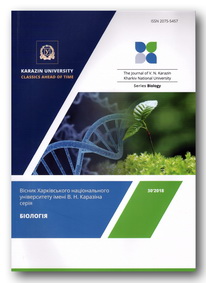Форми та ультраструктурні особливості латеральних крил гельмінта Trichostrongylus tenuis Mehlis, 1846 (Nematoda: Trichostrongylidae)
Анотація
З метою вивчення ультраструктурних особливостей будови нематоди Trichostrongylus tenuis у 2015–2018 рр. у Нахчиванській АР були проведені гельмінтологічні дослідження, і методом повного паразитологічного розтину був зібраний матеріал від домашніх водоплавних птахів. Поряд з тим, що цей гельмінт є специфічним паразитом домашніх водоплавних птахів, він домінує серед усіх зазначених нами видів гельмінтів і є причиною серйозних змін в організмі господаря. Вивчення ультраструктури нематоди T. tenuis має важливу роль у виявленні паразито-хазяїнних відносин, уточненні систематичного положення паразитів і в підготовці заходів боротьби з цими паразитами. Крім цього, велика різноманітність морфологічних особливостей латеральних крил дозволяє використовувати їх як одну з основних ознак для ідентифікації гельмінтів. У статті вперше наводяться дані про ультраструктурні особливості латеральних крил нематоди T. tenuis. У результаті досліджень було встановлено, що, незважаючи на те, що у деяких паразитичних нематод родини Trichostrongylidae морфологічна будова латеральних крил кутикули є однаковою по всій поверхні тіла, у нематоди T. tenuis, що належить до тієї ж родини, при ультраструктурних дослідженнях виявлено 4 форми, особливості яких представлені на схемах і електронограмах. Латеральні крила складаються з кортикального, гомогенного і фібрилярного шарів, що розрізняються за розміром, товщиною та іншими ознаками. На ділянці тіла нематоди T. tenuis від передньої частини (ротової) до початку кишечника кутикула гладенька, на ділянці тіла від тонкого кишечника і далі починають простежуватися латеральні крила, які за формою нагадують «гребінь». У міру наближення до заднього кінця тіла латеральні крила набувають форму «гаків». На хвостовому відділі латеральні крила, ще більш ускладнюючись, набувають форми «шпильок». На латеральних крилах у формі «шипів» додатково спостерігаються відносно дрібні вирости. Ці ознаки можуть використовуватися для уточнення таксономічного положення видів гельмінтів.
Завантаження
Посилання
Bogoyavlinsky Yu.K. (1973). The structure and functions of integumentary tissues of parasitic nematodes. Moscow: Nauka. 205 p. (In Russian)
Dubinina M.N. Parasitological study of birds. Leningrad: Nauka. 140 p. (In Russian)
Ryzhikov K.M. (1967). Key to helminths of domestic waterfowl. Moscow: Nauka. 262 p. (In Russian)
Scryabin K.I. (1928). The method of field helminthological autopsies of vertebrates, including humans. Moscow: Moskow State University. 46 p. (In Russian)
Beveridge I., Durette-Desset M.C. (1992). A new species of trichostrongyloid nematode, Odilia bainae, from a native rodent, Rattus fuscipes (Waterhouse). Transactions of the Royal Society of South Australia, 116, 123–128.
Beveridge I., Durette-Desset M. (1994). Comparative ultrastructure of the cuticle of trichostrongyle nematodes. International Journal for Parasitology, 24, 887–898. https://doi.org/10.1016/0020-7519(94)90015-9
D’Amico F. (2005). A polychromatic staining method for epoxy embedded tissue: a new combination of methylene blue and basic fuchsine for light microscopy. Biotech. Histochem., 80(5–6), 207–210. https://doi.org/10.1080/10520290600560897
Ghasemikhah R., Mirhendi H., Kia E.B. et al. (2011). Morphological and morphometrical description of Trichostrongylus species isolated from domestic ruminants in Khuzestan Province, Southwest Iran. Iranian Journal of Parasitology, 6, 82–88.
Hoberg E.P., Lichtenfels J.R., Piling P.A. (1993). Synlophe of Cooperia neitzi (Trichostrongylidae: Cooperiinae) with comments on vulval inflations and hypertrophy of cuticular ridges among the trichostrongylids. Journal of the Helminthological Society of Washington, 60, 153–161.
Hoberg E.P., Lichtenfels J.R. (1994). Phylogenetic systematic analysis of the Trichostrongylidae (Nematoda), with an initial assessment of coevolution and biogeography. The Journal of Parasitology, 80(6), 976–996.
Kenneth S., Eric H. (1972). The ultrastructure of the adult stage of Trichostrongylus colubriformis and Haemonchus placei. Parasitology, 64, 173–179. https://doi.org/10.1017/S0031182000029590
Kuo J. (2007). Electron microscopy: methods and protocols. Totowa: Humana Press. 625 p. https://doi.org/10.1007/978-1-59745-294-6
Lee D.L. (1965). The cuticle of adult Nippostrongylus brasiliensis. Parasitology, 55, 173–181. https://doi.org/10.1017/S0031182000068463
Lichtenfels J.R. (1977). Differences in cuticular ridges among Cooperiu spp. of North American ruminants with an illustrated key to species. Proceedings of the Helminthological Society of Washington, 44, 111–119.
Martin J., Lee D.L. (1983). Nematodirus battus: structure of the body wall of the adult. Parasitology, 86, 481–488. https://doi.org/10.1017/s0031182000050678
McAllister C.T., Bursey C.R., Freed P.S. (2010). Helminth parasites of amphibians and reptiles from the Ucayali Region, Peru. J. Parasitol., 96(2), 444–447. https://doi.org/10.1645/ge-2206.1
Phosuk I., Intapan P.M., Sanpool O. et al. (2013). Molecular evidence of Trichostrongylus colubriformis and Trichostrongylus axei infections in humans from Thailand and Lao PDR. Am. J. Trop. Med. Hyg., 89, 376–379. https://doi.org/10.4269/ajtmh.13-0113
Roberts L.S., Schmidt G.D., Janovy J. (2009). Foundations of Parasitology. 8th ed. Boston, USA: McGraw-Hill Higher Education. 428 p.
Rzayev F.H. (2013). The comparative analysis of mixed invasions of the domestic waterfowl in different ecological areas of Azerbaijan. Proceedings of the Azerbaijan Institute of Zoology, 31(2), 136–144.
Seyidbeyli M.I., Maharramov S.H., Rzayev F.H. (2019a). Causes of similarity of helminth fauna of domestic waterfowls and wild birds in Nakhchivan AR, parasites specificity. The Journal of Agrarian Science, 1, 58–63.
Seyidbeyli M.I., Maharramov S.H., Rzayev F.H. (2019b). Comparative analysis of mixed invasions in domestic waterfowls in Nakhchivan AR. Scientific publications of Nakhchivan State University, Series of Natural and Medical Sciences, 3, 209–212.
Seyidbeyli M.I., Rzayev F.H. (2018a). Helminth fauna of waterfowl poultry in the territory of Babək reqion of Nakhcivan AR. Journal of Entomology and Zoology Studies, 6(1), 1668–1671.
Seyidbeyli M.I., Rzayev F.H. (2018b). To the study of helminth fauna of geese (Anser anser dom.) and ducks (Anas platherhynchos dom.) in Azerbaijan. Collected materials of the scientific articles of International conference dedicated to 85 years of Prof. R.A.Asgerov. Baku: Tebib, pp. 127–128.
Shahbazi A., Fallah E., Koshki M.H.K. et al. (2012). Morphological characterization of the Trichostrongylus species isolated from sheep in Tabriz, Iran. Res. J. Vet. Sci., 2(5), 309–312.
Wharton D. (1986). The structure of the cuticle and sheath of the infective juvenile of Trichostrongylus colubriformis. Z. Parasitenkd., 72, 779–787. https://doi.org/10.1007/BF00925098
Wilfrida D., Eirini K., Derek B.,Thierry B. (2003). Review of the ultrastructure of the nematode body cuticle and its phylogenetic interpretation. Biological reviews of the Cambridge Philosophical Society, 78(3), 465–510. https://doi.org/10.1017/s1464793102006115
Yildirimhan H.S., Bursey C.R., Altunel F.N. (2011). Helminth parasites of the Balkan green lizard, Lacerta trilineata Bedriaga 1886, from Bursa, Turkey. Turk. J. Zool., 35(4), 519–535. https://doi.org/10.3906/zoo-0910-1
Автори залишають за собою право на авторство своєї роботи та передають журналу право першої її публікації на умовах ліцензії Creative Commons Attribution License 4.0 International (CC BY 4.0), яка дозволяє іншим особам вільно розповсюджувати опубліковану роботу з обов'язковим посиланням на авторів оригінальної роботи.




